Zongzi
Zongzi ([tsʊ̂ŋ.tsɨ]; Chinese: 粽子) or simply zong (also pronounced as "Zhong" in Cantonese) is a traditional Chinese rice dish made of glutinous rice stuffed with different fillings and wrapped in bamboo leaves (generally of the species Indocalamus tessellatus), or sometimes with reed or other large flat leaves. They are cooked by steaming or boiling.[2] In the Western world, they are also known as rice dumplings or sticky rice dumplings.
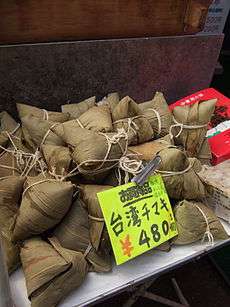 A bunch of rice dumplings tied together with twine | |
| Alternative names | bakcang, bacang, zang, nom asom, Pya Htote , "Joong", "Doong" |
|---|---|
| Type | Rice cake |
| Place of origin | China |
| Region or state | Chinese-speaking areas |
| Main ingredients | Glutinous rice stuffed with different fillings and wrapped in bamboo or reed leaves |
| Variations | Chimaki, Lotus leaf wrap |
| Similar dishes | Mont phet htok |
| Zongzi | |||||||||||||||
|---|---|---|---|---|---|---|---|---|---|---|---|---|---|---|---|
| Chinese | 粽子 | ||||||||||||||
| |||||||||||||||
| Cantonese name | |||||||||||||||
| Chinese | 糉 | ||||||||||||||
| |||||||||||||||
| Southern Min name | |||||||||||||||
| Traditional Chinese | 肉粽 | ||||||||||||||
| |||||||||||||||
Names
As it diffused to other regions of Asia over many centuries, zongzi became known by various names in different languages and cultures, including Pya Htote in Burmese-speaking areas (such as Myanmar), Nom Chang in Cambodia, Bachang in Indonesia, Khanom Chang in Laos and Ba-chang in Thailand.
Vietnamese cuisine also has a variation on this dish known as Bánh ú tro or Bánh tro.
In Singapore, Indonesia, Taiwan and Malaysia, zongzi is known as bakcang, bacang, or zang (from Hokkien Chinese: 肉粽; Pe̍h-ōe-jī: bah-chàng, as Hokkien is commonly used among overseas Chinese). Similarly, zongzi is more popularly known as machang among Chinese Filipinos in the Philippines.
In some areas of the United States, particularly California and Texas, zongzi are often known as Chinese tamales.[3][4]
Double Fifth Festival
Zongzi (sticky rice dumplings) are traditionally eaten during the Duanwu Festival (Doubler Fifth Festival) which falls on the fifth day of the fifth month of the Chinese lunar calendar, and commonly known as the "Dragon Boat Festival" in English.[5] The festival falls each year on a day in late-May to mid-June in the Western calendar.
Popular origin myth
What has become established popular belief amongst the Chinese is that zongzi has since the days of yore been a food-offering to commemorate the death of Qu Yuan, a famous poet from the kingdom of Chu who lived during the Warring States period.[6] Known for his patriotism, Qu Yuan tried to counsel his king to no avail, and drowned himself in the Miluo River in 278 BC.[7][lower-alpha 1]
Qu Yuan died in 278 BC, but the earliest known documented association between him and the zong dumplings occurs much later, in the mid 5th century (Shishuo Xinyu Chinese: 世说新语, or A New Account of the Tales of the World).,[8] And a widely observed popular cult around him did not develop until the 6th century AD, as far as can be substantiated by evidence.[9] But by the 6th century, sources attest to the offering of zongzi on the Double Fifth Festival (5th day of the 5th month of the lunar calendar) being connected with the figure of Quan Yuan.[10]
As for the origin myth, a fable recounts that the people commemorated the drowning death Quan Yu on the Double Fifth day by casting rice stuffed in bamboo tubes; but the practice changed in the early Eastern Han dynasty (1st century AD),[11][lower-alpha 2] when the ghost of Quan Yu appeared in a dream to a man named Ou Hui (Chinese: 區回, 歐回) and instructed him to seal the rice packet with chinaberry (or Melia) leaves and bind it with colored string, to repel the dragons (jialong) that would otherwise consume them. However, this fable is not attested in contemporary (Han Period) literature, and only known to be recorded centuries later in Wu Jun (呉均; Wu chün, d. 520)'s Xu Qixieji (『續齊諧記』; Hsü-ch'ih-hsieh-chih).[12][13][14][15]
Also, Quan Yu had (dubiously, by "folklore" or by common belief) become connected with the boat races held on the Double Fifth, datable by another 6th century source.{{Refn|Jingchu Suishiji 《荊楚歲時記》(6th c.), under the "Fifth Day of the Fifth Month" heading.[16] Modern media has printed a version of the legend which says that the locals had rushed out in dragonboats to try retrieve his body and threw packets of rice into the river to distract the fish from eating the poet's body.[17]
History
The practice of eating zongzi on the Double Fifth or Summer Solstice is concretely documented in literature from around the Late Han (2nd–3rd centuries).[lower-alpha 3]
At the end of the Eastern Han dynasty, people made zong, also called jiao shu (Chinese: 角黍, lit. "horned/angled millet") by wrapping sticky rice with the leaves of the Zizania latifolia plant (Chinese: 菰; pinyin: gu, a sort of wild rice[18]) and boiling them in lye (grass-and-wood ash water).[20] The name jiao shu may imply "ox-horn shape",[18] or cone-shape. That the zong or ziao shu prepared in this way was eaten on the occasion of the Double Fifth (Duanwu)is documented in works as early early as the Fengsu Tongyi (Chinese: 風俗通義, 195 AD).[20] These festive rice dumplings are also similarly described in General Zhou Chu (236–297)'s Fengtu Ji (simplified Chinese: 风土记; traditional Chinese: 風土記, "Record of Local Folkways"[16][21][22] Various sources claim that this Fengtu Ji contains the first documented reference regarding zongzi,[23][24] even though it dates somewhat later than the Fengsu Tongyi.
In the Jin dynasty (晋, 266–420 AD), zongzi was officially a Dragon Boat Festival food.[25] Anecdotally, an official called Lu Xun from the Jin dynasty once sent zongzi which used yizhiren (Chinese: 益智仁, the fruit of Alpinia oxyphylla or sharp leaf galangal) as additional filling; this type of dumpling was then dubbed "yizhi zong" (Chinese: 益智粽, literally "dumplings to increase wisdom").[25][26] Later in the Northern and Southern dynasties, more varieties of rice dumplings appeared, which used additional fillings such as meat, chestnuts, and dates,[27] and were being exchanged as gifts.[25]
In the 6th century (Sui to Early Tang dynasty, the dumpling is also being referred to as "tubular zong" (Chinese: 筒糉/筒粽; pinyin: tongzong), and they were being made by being packed inside "young bamboo" tubes.[28][lower-alpha 4] The 6th century source for this states that the dumplings were eaten on the Summer Solstice,[28] (instead of the Double Fifth).
In the Tang dynasty, the shape of zongzi appeared conical and diamond-shaped. "Datang zongzi" was also recorded in classical-era Japanese literature, which was heavily influenced by Tang Chinese culture.
In the Northern Song Dynasty period, the "New augmentation to the Shuowen Jiezi" (Chinese: 説文新附; pinyin: Shouwen xinfu) glossed zong as rice with reed leaves wrapped around it.[lower-alpha 5][29] Also during the Song Dynasty, there were many preserved fruit zongzi. At this time also appeared a pavilion filled with zongzi for advertising, which showed that eating zongzi in the Song dynasty had been very fashionable.[30]
In the Yuan and Ming dynasties, the wrapping material had changed from gu leaf to ruo (箬; the Indocalamus tessellatus bamboo) leaf, and then to reed leaves, and filled with materials like bean paste, pine nut kernel, jujube, walnut and so on. The varieties of zongzi were more diverse.
During the Ming and Qing dynasties, zongzi became auspicious food. At that time, scholars who took the imperial examinations would eat "pen zongzi", which was specially given to them at home, before going to the examination hall. Because it looked long and thin like a writing brush, the pronunciation of "pen zongzi" is similar to the Chinese word for "pass", which was for good omen. Ham zongzi appeared in the Qing dynasty. [31]
Until now, every year in early May of the lunar calendar, the Chinese people will soak glutinous rice, wash the leaves and wrap up zongzi. The types of zongzi are more variety.
Description
The shapes of zongzi vary,[32] and range from being approximately tetrahedral in southern China to an elongated cone in northern China. In the Chiang Kai-shek Memorial Hall in Taipei, plastic mock-ups of rectangular zongzi are displayed as an example of the zongzi eaten by Chiang Kai-shek. Wrapping zongzi neatly is a skill that is passed down through families, as are the recipes. Making zongzi is traditionally a family event of which everyone helps out.
While traditional zongzi are wrapped in bamboo leaves,[33] the leaves of lotus,[34] reed,[35] maize, banana,[36] canna, shell ginger and pandan sometimes are used as substitutes in other countries. Each kind of leaf imparts its own unique aroma and flavor to the rice.
The fillings used for zongzi vary from region to region, but the rice used is almost always glutinous rice (also called "sticky rice" or "sweet rice"). Depending on the region, the rice may be lightly precooked by stir-frying or soaked in water before using. In the north, fillings are mostly red bean paste and tapioca or taro. Northern style zongzi tend to be sweet[37] and dessert-like. Southern-style zongzi, however, tend to be more savory or salty.[37] Fillings of Southern-style zongzi include salted duck egg, pork belly, taro, shredded pork or chicken, Chinese sausage, pork fat, and shiitake mushrooms.
Zongzi need to be steamed or boiled for several hours depending on how the rice is prepared prior to being added, along with the fillings. However, as the modes of zongzi styles have traveled and become mixed, today one can find all kinds of zongzi at traditional markets, and their types are not confined to which side of the Yellow River they originated from.
Fillings
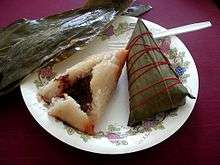
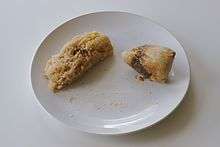
- Mung beans, split and dehulled
- Red bean paste[32]
- Chinese sausage[34]
- Jujube[32]
- Salted chicken fat
- Mushrooms[34]
- Chinese black mushrooms
- Salted eggs
- Ham[34]
- Hard boiled eggs[32]
- Nuts[34]
- Chestnuts[38]
- Cooked peanuts
- Pork[34]
- Conpoy (dried scallops)
- Red-cooked meats
- Chicken[38]
- Yam
- Vegetables
- Lotus seed
Variations
China
- "Jiaxing zongzi" (嘉兴粽子): It is a kind of zongzi famous in mainland China and named after the city Jiaxing. The filling is typically pork but also can be mung beans, red beans or salted duck eggs.
- Jia zong (假粽): Instead of glutinous rice, balls of glutinous rice flour (so no individual grains of rice are discernible) are used to enclose the fillings of the zongzi. This zongzi are typically smaller than most and are much stickier.
- Jianshui zong (碱水粽): Meaning "alkaline water zong," these are typically eaten as a dessert item rather than as part of the main meal. The glutinous rice is treated with jianzongshui (碱粽水, lye zongzi water, aqueous sodium carbonate), or potassium carbonate, giving them their distinctive yellow color. Jianshui zong typically contain either no filling or are filled with a sweet mixture, such as sweet bean paste. Sometimes, a certain redwood sliver (蘇木) is inserted for color and flavor. They are often eaten with sugar or light syrup.
- Nyonya chang (娘惹粽): A specialty of Peranakan cuisine, this zongzi are made similarly to southern zongzi. However, the filling is typically minced pork with candied winter melon, ground roasted peanuts, and a spice mix.[39]
- Cantonese jung (广东粽): It is the representative of the southern variety of zongzi, which is more common with fresh meat zongzi with chicken, duck, char siu pork, such as the deployment of stuffing dumplings. Cantonese jungs are small, the front is square, back has a raised sharp Angle, shape like an awl.[40]
- Banlam zang (闽南粽): Xiamen, quanzhou area is very famous for its pork dumplings. Pork zongzi braised pork with pork belly plus mushrooms, shrimp and so on.[41]
- Sichuan zong (四川粽): Sichuan people like to eat spicy food, so they make spicy rice dumplings. They will add sichuan peppercorns, chili powder, sichuan salt and a little preserved pork into the dumplings, wrapped into four-cornered dumplings. Cooked and then roasted, it tastes tender and flavorful.[42]
- Beijing zong (北京粽): They use red dates, bean paste as stuffing, a few also use preserved fruit as stuffing. Cold eating is the local characteristics of zongzi, so also known as cold zongzi, summer if you can put in the refrigerator after the ice to eat, better flavor.[43]
Taiwan
- The northern Taiwanese zongzi (北部粽) are wrapped with husks of Phyllostachys makinoi bamboo (桂竹籜), then steamed; southern Taiwanese zongzi (南部粽) are wrapped with leaves of Bambusa oldhamii (麻竹葉), then boiled.
Making methods
1. Leaves selection: reed leaves zongzi leaves in different regions, with regional disparity varies from place to place, the multi-purpose reed Ye Zhu, or WeiYe, hainan island areas in China also use a lingnan unique plant "Zhong leaf as wrapped in reed leaves, usually triangular shape, cone shape or pyramid shaped. In central China, the leaves of zongzi are mostly quercus leaves, which are rectangular
2. Filling of seasonings: bacon dumplings to the first will be fresh pork with a little MSG, sugar, wine, salt, light soy sauce mix and rub repeatedly until the seasoning into the pork package.
3. The bundle of zongzi: bean paste zongzi should not be tied too tightly, to prevent the rice grains into the bean paste, if not thoroughly cooked will appear sandwich-sheng phenomenon. If the bacon dumplings with fat pork should not tie tight, tight can be appropriate.
4. Zongzi cooking: boiled dumplings must boil water before falling zongzi, water to soak the zongzi noodles, to re-boil after another fire for 3 hours
Gallery
- Variations of zongzi
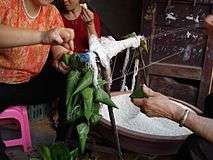 Making (and eating) zongzi
Making (and eating) zongzi- Zongzi tied with leaves
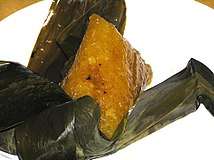 Jianshui zongzi without fillings
Jianshui zongzi without fillings
See also
Explanatory notes
- After composing the Jiu Zhang ("Nine Declarations") part of the Chu ci; this according to Wang Yi, the ancient (Han dynasty period) commentator to Qu Yuan as a poet.[7] (More specifically, penning Lament for Ying portion of the Nine Declarations when the Qin general Bai Qi captured Yingtu, then the capital of Chu, in 278 BC).
- The first year of Eastern Han (Year 1 of Jianwu era, 25 AD) to be more precise.
- The claim that the zongzi dates to the Spring and Autumn Period occurs in a book by a non-expert (Dong Qiang, a French literature professor and translator), and only an unnamed "Record" is cited as evidence.[18] Other web sources concur with this claim.[19]
- Here following Ian Chapman who renders (tong zong) as "tubular zong".[16]
- The original Shuowen Jiezi dates to c. 100 AD, but this character was added to the dictionary in the 10th century. The leaf plant is given as lu (simplified Chinese: 芦; traditional Chinese: 蘆; pinyin: lu), or "reed".
References
- Citations
- Cantodict, 粽 (zung2 zung3 | zong4) : glutinous rice dumpling
- Roufs, T.G.; Roufs, K.S. (2014). Sweet Treats around the World: An Encyclopedia of Food and Culture. ABC-CLIO. p. 81. ISBN 978-1-61069-221-2. Retrieved November 5, 2016.
- "'Chinese tamales' tastily fete culture". October 14, 2013.
- http://luckyrice.com/grandma-hsiangs-chinese-tamales/
- "Zongzi fever". Global Times. June 11, 2015. Retrieved November 5, 2016.
- Hawkes (1985), pp. 64–66.
- Zhang, Hanmo (2018). "The Author as an Individual Writer: Sima Qian, the Presented Author". Authorship and Text-making in Early China. e Gruyter. p. 245. JSTOR j.ctvbkk21j.9.CS1 maint: ref=harv (link)
- Ma, Xiaojing 马晓京 (1999), Zhongguo 100 zhong minjian jieri 中国100种民间节日 [100 kinds of folk festivals in China], Guangxi renmin chuban she, p. 200, ISBN 7-219-03923-9
- Chittick (2010), p. 111: "there is no evidence that he was widely worshiped or much regarded in popular lore prior to the sixth century CE".
- Wu Jun (呉均; Wu chün (d. 520), Xu Qixieji. See below.
- Lee-St. John, Jeninne (14 May 2009). "The Legends Behind the Dragon Boat Festival". Smithsonian Magazine.
- Chi, Hsing (Qi Xing) (2000). "Chu Yuan". Classical and Medieval Literature Criticism. 36. Gale Research Company. pp. 125, 95 (in brief), 132 (notes). ISBN 0-78764-378-5.CS1 maint: ref=harv (link): "chiao-lung"
- Chan, Timothy Wai Keung (July–September 2009). "Searching for the Bodies of the Drowned: A Folk Tradition of Early China Recovered". Journal of the American Oriental Society. 129 (3): 385 and n1. JSTOR 20789417.CS1 maint: ref=harv (link)
- Gujin Tushu Jicheng 『古今圖書集成』Book 51, excerpt from "Xu Qixieji《續齊諧記》 .
- Chan (2009) citing Wu Jun Xu Qixie though not explicitly mentioning zong, only paraphrasing as "rice wrapped with five-colored strings".[13]
- Chapman, Ian, ed. (2014), "28 Festival and Ritual Calendar: Selections from Record of the Year and Seasons of Jing-Chu", Early Medieval China: A Sourcebook, Wendy Swartz; Robert Ford Campany; Yang Lu: Jessey Choo (gen. edd.), Columbia University Press, p. 479, ISBN 9780231531009
- The origin of tsungtsu Archived May 15, 2007, at the Wayback Machine
- Dong, Qiang (2016). Yinshi Juan 飲食卷 [Diet]. Wei Jingqiu 隗静秋 (tr.). Anhui People's Publishing House. p. 99. ISBN 9781921816918.CS1 maint: ref=harv (link)
- "端午吃粽子及粽子的历史演变历程". baijiahao.baidu.com.
- Gujin Tushu Jicheng 『古今圖書集成』 Book 51, excerpt from "Fengsu Tongyi《風俗通義》".
- Hsu (2004), pp. 39–40.
- Beijing Foreign Languages Press (2012). Chinese Auspicious Culture. Shirley Tan (tr.). Asiapac Books. p. 36. ISBN 9789812296429.CS1 maint: ref=harv (link)
- Li, Yunnan 李雲南 (2018), 田兆元; 桑俊 (eds.), "Jingchu diqu duanwu yinshi minsu tanxi" 荊楚地区端午饮食民俗探析 [Analysis of the folklore of eating and drinking habits on the Double Fifth in the Jingchu region], 『追本溯源——凤舟竞渡暨端午文化学术研讨会论文集』, Beijing Book Co. Inc., ISBN 9787307200487
- Wu, Yue 望岳 (2007). Ershisi jieqi 二十四節氣與食療 [Twenty-four solar terms prescribed food therapy]. Jilin Science and Technology Press 吉林科学技术出版社.CS1 maint: ref=harv (link)
- "Zongzi fazhanjianshi." 粽子发展简史:古称 “角黍” 晋代加入中药材-新华网 [Brief developmental history of the zongzi dumpling..]. www.xinhuanet.com.
- Zheng, Jinsheng; Kirk, Nalini; Buell, Paul D.; Unschuld, Paul U. (2016). Dictionary of the Ben Cao Gang Mu, Volume 3: Persons and Literary Sources. University of California Press. p. 313. ISBN 9780520291973.CS1 maint: ref=harv (link)
- Actually, "chestnut and jujube dates" (Chinese: 栗棗) were already documented in the Fengsu Tongyi account of zong.[20]
- Jingchu Suishiji 《荊楚歲時記》(6th c.), under the "Summer Solstice" heading.[16]
- Xu, Ruoxin 許若馨 (25 June 2020). "Duanwu jie / zong, zong, zong nage zi cai zhengcue?" 端午節|糉、粽、糭哪個字才正確?中文系講師端午節「糉」字逐個解 [Double Fifth Festival/zong, zong, zong which character is correct?]. Ming Pao 明報., citing scholar Hung Yeuk Chun 若震認.
- "粽子大家都爱吃,粽子的起源你知道吗?来看看粽子的发展简史吧". baijiahao.baidu.com.
- "端午节吃粽子的来历由来__中国青年网". news.youth.cn.
- Schmidt, A.; Fieldhouse, P. (2007). The World Religions Cookbook. Greenwood Press. pp. 27–28. ISBN 978-0-313-33504-4. Retrieved November 5, 2016.
- Thurman, Jim (June 9, 2016). "Where to Find Chinese Zongzi, the Sweet Pork-Filled Tamales Wrapped in Bamboo". L.A. Weekly. Retrieved November 5, 2016.
- Liao, Y. (2014). Food and Festivals of China. China: The Emerging Superpower. Mason Crest. p. pt68. ISBN 978-1-4222-9448-2. Retrieved November 5, 2016.
- Jing, J. (2000). Feeding China's Little Emperors: Food, Children, and Social Change. Stanford University Press. p. 105. ISBN 978-0-8047-3134-8. Retrieved November 5, 2016.
- Mayhew, B.; Miller, K.; English, A. (2002). South-West China. LONELY PLANET SOUTH-WEST CHINA. Lonely Planet Publications. p. 121. ISBN 978-1-86450-370-8. Retrieved November 5, 2016.
- Gong, W. (2007). Lifestyle in China. Journey into China. China Intercontinental Press. pp. 12–13. ISBN 978-7-5085-1102-3. Retrieved November 5, 2016.
- Stepanchuk, C.; Wong, C.C. (1991). Mooncakes and Hungry Ghosts: Festivals of China. China Books & Periodicals. p. 47. ISBN 978-0-8351-2481-2. Retrieved November 5, 2016.
- "Nyonya Rice Dumplings Recipe (Zong Zi) 娘惹粽子 - Huang Kitchen".
- "中国到底哪里的粽子最好吃?". baijiahao.baidu.com.
- "闽南正宗烧肉粽,清香四溢,油而不腻,保证让你回味无穷". baijiahao.baidu.com.
- "各地区不同特色粽子,你都吃过吗?". baijiahao.baidu.com.
- "不同地区的粽子,你了解多少?". www.sohu.com.
- Bibliography
- Chittick, Andrew (2010), Patronage and Community in Medieval China: The Xiangyang Garrison, 400-600 CE, SUNY Press, pp. 112–113, ISBN 9781438428994
- Hawkes, David (1985). The Songs of the South: An Anthology of Ancient Chinese Poems by Qu Yuan and Other Poets. Penguin Books.CS1 maint: ref=harv (link)
- Hsu, ManLi 許曼麗 (2004), "Tango fūbutsushigo shōkō" 端午風物詩語小考 [A study about poems of 'Duan-wu'] (PDF), The geibun-kenkyu: journal of arts and letters 藝文研究 (in Japanese): 39–67